5 Important Digital Marketing Channels & When to Use Them
Are you looking to implement digital marketing to acquire more customers, but don’t know which channels to tap on? This article explores 5 important digital marketing channels and offers insights into how you can best leverage them for optimal results in your digital marketing campaigns.
What Are Digital Marketing Channels?
Digital marketing channels are the touchpoints you have with your target audience. In a digital marketing campaign, these channels are strategically selected to influence prospective customers to engage with your brand and ultimately purchase your products or services.
In order to effectively shape a customer’s emotions and perceptions about your brand, you’ll first need to understand where your customer is on their journey. This journey is known as the customer journey or user journey, and it can be illustrated using the marketing funnel.
Laying the foundation – The Marketing Funnel
The marketing funnel is an extremely important concept in marketing that should underlie key marketing decisions. It breaks down the customer journey into 4 main stages – this allows for more efficient planning of channel usage at each stage. Here’s what the marketing funnel looks like:
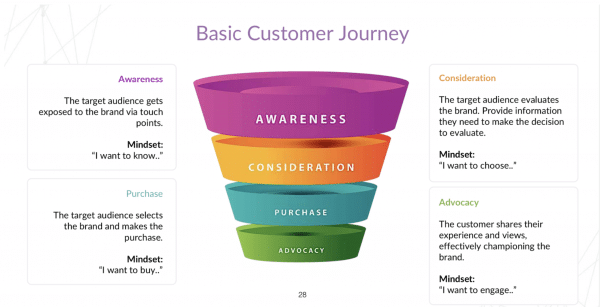
The customer journey along the marketing funnel.
It’s crucial marketers understand each stage of the funnel so that they use the right digital channels at each stage to move a customer from one stage to the next.
Stage 1: Awareness
Awareness sets the foundation for the subsequent stages. In this stage, the main objectives are to educate customers and increase brand awareness.
Stage 2: Consideration
Consideration is where potential customers decide whether or not they require your product or service. Trust building with your customers is very crucial here.
Stage 3: Purchase
At this stage, it’s important to highlight how your product or service is distinctly different from your competitors, to convince customers you are the right choice.
Stage 4: Advocacy
The last stage is where you should aim to retain and engage customers after successfully converting them. Ensure they have a strong brand recall – the objective is to make them loyal advocates of your brand. Word-of-mouth reviews are powerful.
Now that you understand the customer journey, it’s now time to understand 5 important digital marketing channels that can move them along their journey:
- Organic Search
- Paid Search
- Display Advertising
- Social Media
Channel 1 – Organic Search
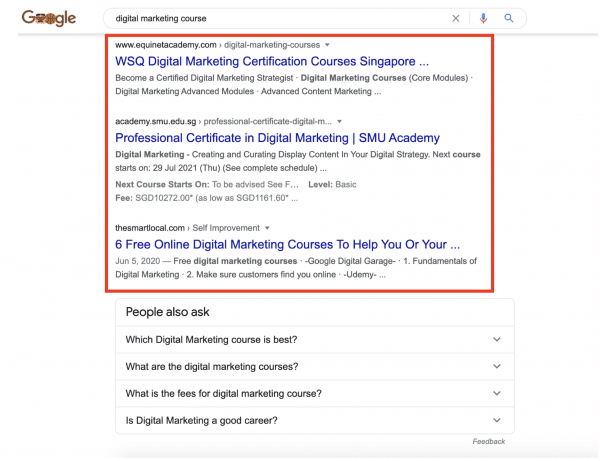
Example of organic search results on Google’s search engine result page.
What is Organic Search?
According to the Content Marketing Institute, organic search is the largest source of non-paid website traffic. It is therefore important to leverage it as best you can. After all, as long as you have a website, are on social media or have a business page, you can show up on the organic search – the question is, will it be on page 1 or page 10?
How does Organic Search Work?
To answer this question, we have to first understand how organic search works – organic search is a tool that connects prospective customers with your company.
In this day and age, your prospective customers are searching for your product or service or any related information on search engines like Google, Bing or Yahoo!. These search engines then answer their query by listing the top ranking websites that have the most relevant information.
The higher up your website ranks, the more likely you will get clicks, and therefore, your chance of converting potential customers increases. The key to using organic search to boost your business is to apply the right Search Engine Optimisation (SEO) techniques.
According to an industry study done by ClickFlow and Backlinko, research has shown that the first result on Google gets 31.7% of all clicks, while the second page’s results get a mere 0.78%.
If you’d like to find out more about SEO, here’s an article that explains what it is and how it works.
The Pros and Cons of Organic Search
As with any of the digital marketing tools you’ll encounter in this article, Organic Search has its own set of pros and cons.
Pros
1. Draws Customers With Purchase Intent
When a prospective customer uses a specific keyword to research a product, service, business or query, it signifies a high intention and a need on the customer’s part. Therefore if they encounter your website on the first page of a search engine, these are customers who are more likely to convert on your site.
2.Good Source of High Traffic Volume
For organic search engines, Google is the number 1 in the world, receiving more than 3.5 billion searches daily. If your website is able to rank on the first page of Google with proper SEO techniques, your business will be able to convert a lot more customers.
3. Sustainable
Organic search is a sustainable digital marketing channel to drive non-paid traffic over a long period of time. After all, as long as you have the resources and skills to consistently rank on the first page of the Search Engine Results Pages (SERP), getting traffic to your website will not be an issue.
4. Builds Trust and Industry Authority
Ranking high on the organic search engine results pages demonstrates that you have domain authority, as search engines tend to rank web pages they trust higher. It is also likely that you will be seen as an industry leader, thereby building trust between you and your customers.
Cons
1. Technical Expertise Required
There are hundreds of ranking factors that determine the order of websites that are displayed on the search engine results pages (SERPs). It is therefore not easy to outrank competitors unless there is someone with sound SEO knowledge working to plan and execute on and off-page SEO on a regular basis.
2. Time Delay
With the multitude of websites that are on the Internet, it requires time for search engine spiders to crawl through and rank your website. Typically, it takes around 3 to 6 months to see results from SEO. Fortunately, organic traffic from SEO grows over time.
3. Costly to Maintain
Companies have to spend on resources to create and maintain the quality of their content in a bid to rank and maintain their ranking positions on Google. This includes SEO tool subscriptions, content writers, and even an SEO specialist – this could be in-house, a freelance consultant or an agency.
4. The Algorithms are Constantly Updating
Google tweaks its algorithms often. To stay ahead of the competition, you or whoever is handling SEO in your company needs to be aware of the changes and constantly be tweaking keywords, optimising existing content, and thinking of creative and relevant new content.
When to use Organic Search?
Organic search is best used at all stages of your customer’s journey, particularly the purchase stage, where searchers with high purchase intent are likely to buy something after conducting a search.
Organic Search in Action
To allow better understanding of how organic search might look like for a brand, let’s take a look at Amazon. This long-tail keyword “afterglow wireless headset ps4” is a high purchase intent keyword, and it is imperative that a brand ranks on the first page of Google to increase sales.
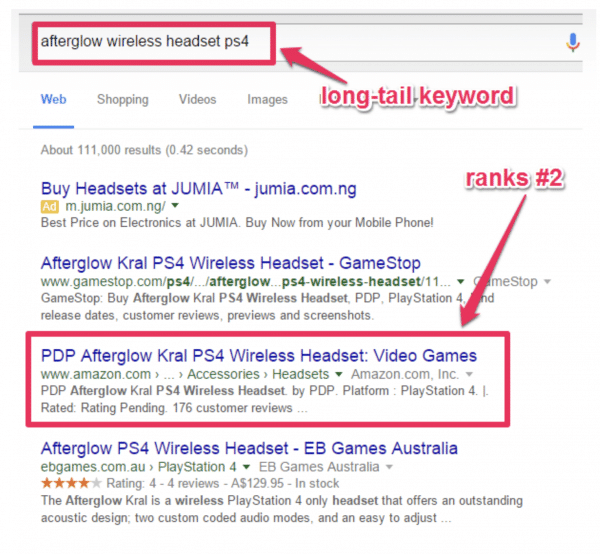
How Amazon utilises organic search to rank high on SERP.
Channel 2 – Paid Search
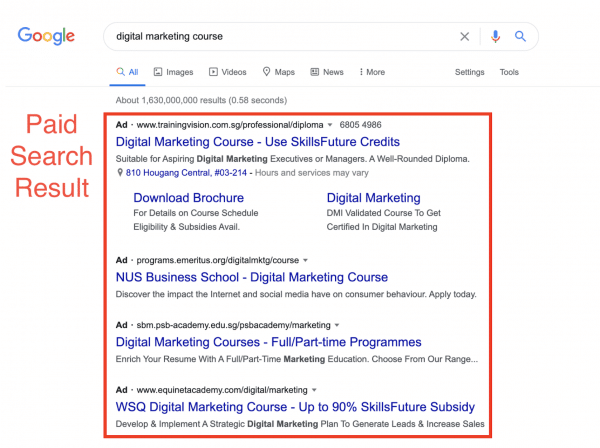
Example of paid search advertisements appearing on Google’s search engine result page.
What is Paid Search?
You may think of Paid Search as SEO’s cousin. Essentially, paid search is similar to SEO in that it generates high-quality leads and conversions by attracting high intent visitors to your site. Paid search results show up on the top and bottom of SERPs
For most businesses, paid search is one of the most efficient advertising channels because it is great at generating high-quality leads and conversions in a short span of time.
After all, your prospective customers would only discover your website on a SERP if they searched using a keyword that is related to your product or service.
Also known as Search Engine Marketing (SEM), we cover the topic in this article.
How does Paid Search Work?
There is only one payment model that is used with paid search.
The Pay-Per-Click (PPC) or Cost-Per-Click (CPC) model. This model allows advertisers to only be charged when their search advertisements are clicked by someone.
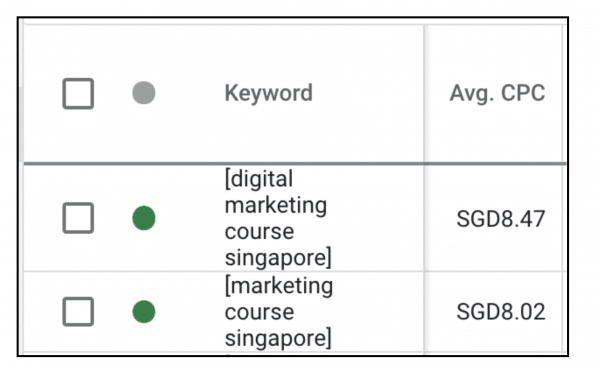
Screenshot of keywords average cost-per-click from Google Ads.
How high or low you rank on SERP depends on the amount you are willing to pay during the bidding process. Google will recommend a bidding amount, but it’s up to you how high or low you want to pay per click based on that amount.
Another factor to consider is the quality score on your paid search ad. This is also determined by Google, and it’s based on the expected click-through rate, the ad relevance to your keyword and the landing page experience.
Ultimately, your bidding amount and quality score combined will determine how high or low your paid search ad appears on SERP.
The Pros and Cons of Paid Search
As with any of the digital marketing tools you’ll encounter in this article, Paid Search has its own set of pros and cons.
Pros
1. Easier to Get Started than Traditional Advertising
Paid search doesn’t need advertisers to pay a hefty amount of money to advertise, unlike some other forms of digital advertising and legacy advertising that require a five-figure budget just to get started. You decide the amount of money you’re willing to spend per click, and that’s a huge advantage compared to other forms of paid advertising.
2. Trackable and Measurable
Most platforms of paid search advertising provide detailed analytics information of the campaigns. These details may include things like performance based on keywords used, to allow advertisers to understand which keywords work and which don’t. Also, budgets can be tracked as well as other granular data, which ultimately allows you to better understand and therefore improve your existing campaigns or start new ones.
3. Speed and Real-Time Amendments
Getting a digital advertising campaign such as paid search going is significantly more efficient compared to traditional advertising. In traditional advertising, the advertiser and publisher have to undergo a series of checks before the campaign can even start. With digital advertising, it’s just on the marketer to launch and stop a campaign with the click of a button. Besides this, the speed of reaching the top of a search engine results page is exponentially increased compared to SEO.
Again, like most digital marketing efforts, paid search campaigns allow audience targeting to allow only specific people to see the ads. For example, some campaigns can solely target women and leave all men out within the target demographic, allowing minimal ad wastage and better budget allocation.
Cons
1. Technical Expertise Required
Like organic search, there needs to be someone who has platform knowledge and understands how to set up an SEM campaign. The person also needs to have technical expertise like keyword research, data analysis and campaign optimisation. Companies will also need to be kept abreast of the latest updates that paid search platforms will have to maximise budget efficiency.
2. Ad Budgets are Finite
After spending the right amount of money, companies may find themselves ranking on the first page of SERP in merely a few hours after the money is spent. However, this is temporary, and once the campaign’s budget is run dry, the ads will be nowhere to be found. This is why it is recommended that SEM and SEO campaigns be run concurrently.
3. Costly to Maintain
The demand for keywords in paid search advertising is always rising. However, there are only a finite number of spots available on the first page of SERP. This is inevitably leading to the rise in the cost of paid search advertising.
4. Rise of Click-Fraud
Click fraud is when either an individual, generated script or computer program repeatedly clicks on a PPC advertisement, thereby falsely charging the advertiser. This is done by not only competitors, but also publishers and even customers occasionally (although this is not exactly click fraud, but something that only looks like it because a customer falsely clicks on an ad multiple times).
Fortunately, Google has introduced invalid clicks, through which it identifies fraudulent clicks and deems them invalid, thereby filtering them out.
When to use Paid Search?
Paid search desires the same outcome as organic search, only the means to get to the first page of SERP differ. Therefore, it’s best used in the purchase stage of your customer’s journey.
Unsure if SEO or SEM will work best for your business? We compare the two here.
Paid Search in Action
Looking at Amazon once again, they understand that SEO isn’t the only way to rank high on SERP. They also use paid search to achieve the same results as SEO, only paid search provides results much faster than SEO.
It should be noted however, that using paid search and organic search in tandem is important, and relying on one solely isn’t the most effective tactic. Let’s take a look at a common long-tail keyword that is searched, “wireless headphones Singapore”.
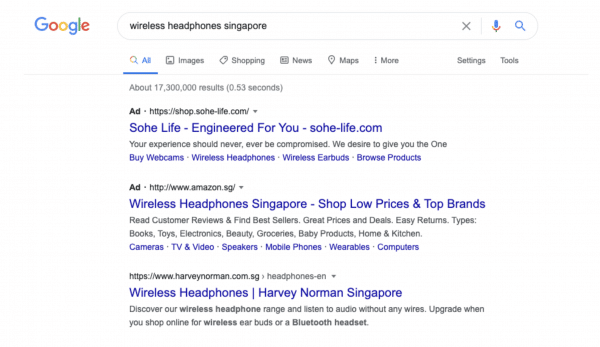
How Amazon utilises paid search to rank high on SERP.
It can be seen that Amazon’s paid search ad for a long-tail keyword, ranks them at #2 on SERP.
Channel 3 – Display Advertising
What is Display Advertising?
Display advertising consists of graphic advertisements that may take the form of text, images, audio, video, flash, banners or any combination of these, that are shown on websites or mobile apps.
If you’re new to advertising in general, take a look at our blogpost on why it’s important.
How does Display Advertising Work?
One of the most common platforms that display advertisements can be found on is the Google Display Network. You’ve probably heard of Google display ads – essentially, the Google Display Network is where Google display ads are showcased.
The Google Display Network is a collection of websites, apps and videos that number over 2 million, making it an extremely popular platform for digital marketers to use.
If you’re wondering what display ads look like, here are 3:
a.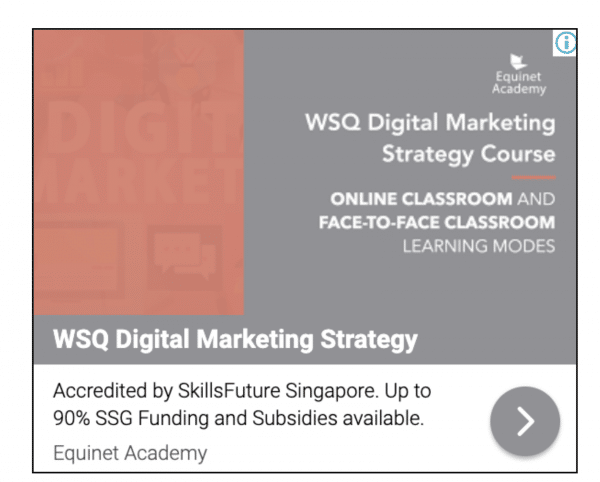
Example of a display ad on the Google Display Network.
b.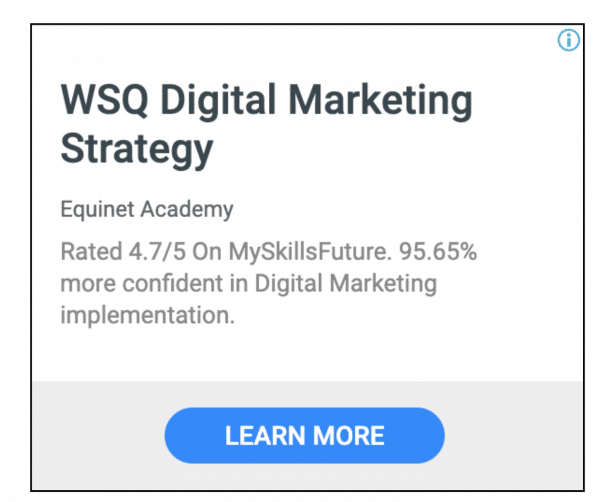
Example of a display ad in the headline format on the Google Display Network.
c.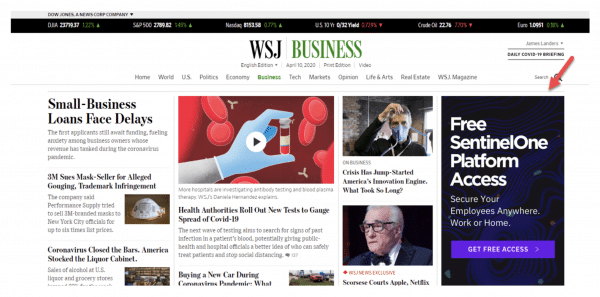
Example of a display ad within a page on a website.
The Pros and Cons of Display Advertising
Pros
1. Format is Appealing
Advertisers are able to use images, videos and interactive media in display advertising, thereby maximising its appeal to people who are each attracted to various formats. The attractive content that display advertising can produce to garner the attention of prospects is one the biggest advantages of display advertising.
2. High Visibility in the Digital Space
The Google Display Network is always expanding, and so are other ad placement platforms. What this means is that there is an increasing number of websites becoming a part of these ad networks, which translates to more opportunities for advertisers to have their ads on relevant websites that would best capture the attention of their target audience.
3. Easy to Optimise for Better Results
Digital ads are able to leverage machine learning to better optimise campaigns to achieve the marketer’s desired results. For instance, if the campaign’s objective is to reach out to a certain demographic, the algorithm will optimise the campaign to hit that target audience as best it can.
4. Easy to Track and Measure
Display advertising, like most digital marketing channels, is able to provide granular data to the campaign manager, thereby allowing him/her to gain the insights necessary to better optimise the campaign and achieve better results.
Cons
1. Targets Users with Low Intent
Unlike organic search and paid search campaigns where potential users search up your product, display advertising is usually shown to users when they are not looking to view your product or service. Conversions are therefore much lower with display advertising campaigns.
2. More Difficult to Control Where Ads Appear
Unlike traditional advertising where the placement of the ad is carefully curated, with display advertising, there is little control over where your ads will pop up on a website or mobile application on a content level.
For instance, an airline company’s ad may pop up beside news of a tragic plane crash. The airline company would have to do preliminary research to pre-identify websites they want to omit their ad placements, and may overlook some negative placements along the way. Regular tracking and analysis would be required to spot and remove any negative placements via the ad campaign settings.
3. Technical Expertise Required
The process of setting up, analysing and optimising a display ad campaign requires technical expertise on the advertiser’s part. Once technical expertise is there, however, these processes can be completed in a very short period of time.
4. Risk of Ad Fraud
There are many methods that ad fraudsters use to intercept or stop a digital ad from being seen by its target audience. One of the most common methods of interception is to set up bots to manipulate the clicks and impressions an ad gets. What this does is give the campaign manager false information through analytics software that will lead to wrong follow-up actions.
Display advertisements may be used at 2 stages of a customer’s journey. First, awareness if the customer hasn’t seen the product before. Second, at the consideration stage if the ad is a retargeted ad to a prospective customer who has visited your site before and is already aware of your product or service.
Display Advertising in Action
To illustrate display ads in each of these 2 stages, let’s use LinkedIn as an example. Here is what one of their ads looks like in the awareness stage:
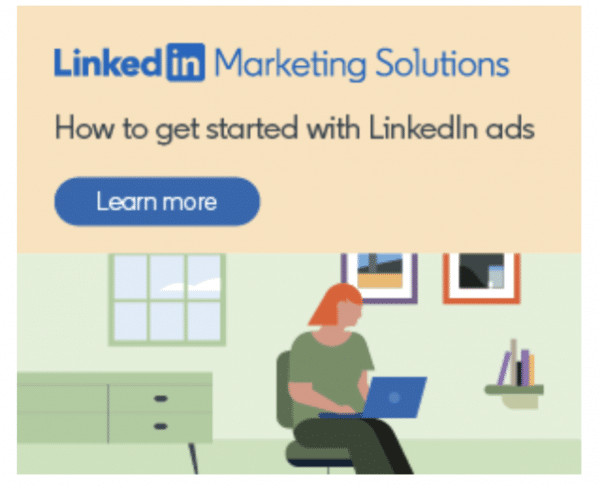
A LinkedIn display ad at the awareness stage.
At this stage, the call to action is to learn more about the service they are offering. The ad is driving customers to read about how they can get started with the service. This builds interest with the target customer while driving them down the funnel to the consideration stage.
At the next stage, consideration, their ad looks like this:
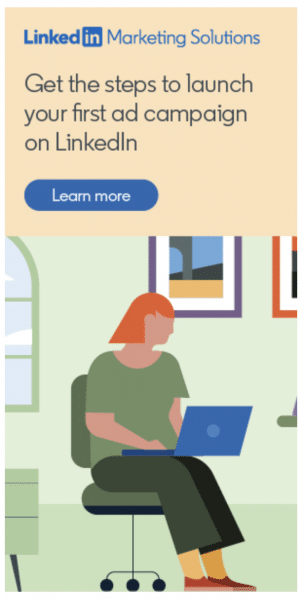
A LinkedIn display ad at the consideration stage.
This ad provides the prospective customer with value by offering them the steps to launch their first ad campaign on LinkedIn. By this time, the customer would already know a little bit about the service LinkedIn is offering if they clicked on LinkedIn’s awareness stage ad. Now, it’s up to LinkedIn to convince their customer that their service will benefit them, in order to drive them to the next stage – purchase.
Want to know more about LinkedIn ads? Check out our definitive guide here.
Channel 4 – Social Media
What is Social Media?
You’ve probably heard of Facebook, Instagram, Twitter and LinkedIn. There are also new platforms like Clubhouse steadily gaining popularity.
In essence, social media is a computer-based technology that allows users to share information via the networks they have access to on these social media platforms. The medium they use to share information would differ widely, depending on which social media platform they are using. Clubhouse for example is purely an audio platform.
With social media users numbering 4.2 billion people worldwide at the start of 2021, it’s in the vested interest of brands worldwide to leverage these platforms to market their products.
How does Social Media Marketing Work?
Marketers should use social media to create unique content that speaks to their target audience. This may come in the form of blog articles, videos, carousel posts and podcasts among many other forms of content.
Not only this, but brands should engage with their audiences to build rapport and gain mindshare with them. This may be done through answering questions and actively responding to comments with a tone that is aligned to your brand’s persona.
Social media is also a good place to do advertising. Platforms like Facebook allow you to target your audience demographic, interests and behaviour.
We give a rundown on what social media marketing is in a previous article that can be found here.

A Facebook Ad from IKEA.

A Facebook Ad from NTUC FairPrice.
The Pros and Cons of Social Media Marketing
Pros
1. Your Customers Spend Most of their Time Here.
According to Statista, the daily average social media usage of internet users worldwide is 145 minutes per day as of 2019 and 2020. In addition to this, The Next Web, a technology-focused media company, states that a quarter of social media users between the ages of 16-64 use social media networks to conduct product research online. It can therefore be seen that implementing a strong social media strategy will greatly increase brand awareness.
2. Content can be Spread Rapidly
Every post you create that adds value to your audience has an increase in its ability to be shared to their personal networks, thereby increasing your brand awareness amongst people who might’ve previously never heard of your business.
3. Tap on Untapped Markets
Your business may see an increase in traffic to your website as social media allows you to target demographics that you might not be able to reach on other digital channels you’re using. This can be done by adjusting your demographic settings when advertising on social media, or creating content that is viral, as mentioned above.
4. Connect Directly With Your Audience
When your brand has a persona on social media, this humanises it, especially if you regularly engage in dialogue with your audience. Since people prefer to do business with other people rather than companies, leveraging social media in this manner can potentially lead to higher conversion rates. It’s also important to leverage social media advertising to showcase your brand, its products and services to your audience. Properly crafted and targeted social media ads are a great source of traffic and leads.
Cons
1. Negative Feedback is Publicly Displayed
If someone has a poor experience with your product or service, they might very well turn to your social media page to write a bad review, or perhaps do so on their own social media page. Since content can be spread rapidly on social media, this might have a severe negative impact on your business.
2. Social Media Strategies Require Expertise
Coming up with social media strategies and a content calendar may be overwhelming, as is finding the time to post content, monitor responses and measure the effectiveness of your content and ads on social media platforms. This might mean having to hire a social media manager or an agency to handle this aspect of your business.
3. Results Take Time
To see a positive Return of Investment (ROI) on your social media strategies, it’ll take time. Efforts need to be sustained over a period of time to determine the effectiveness of a campaign — patience is key.
4. Cancel Culture
Cancel culture is more rampant today than it has ever been. While there are many positive impacts that come about because of it, as a business, you should be acutely aware of the content you put online, as well as how you respond to your audience.
Case in point: On International Women’s Day this year, Burger King UK put out a tweet saying “Women belong in the kitchen”. The intent behind the tweet was to raise awareness of the lack of opportunities for women in professional kitchens in the UK. However, an overwhelming group of people took offence to the tweet, leading to Burger King UK deleting their tweet and issuing an apology.
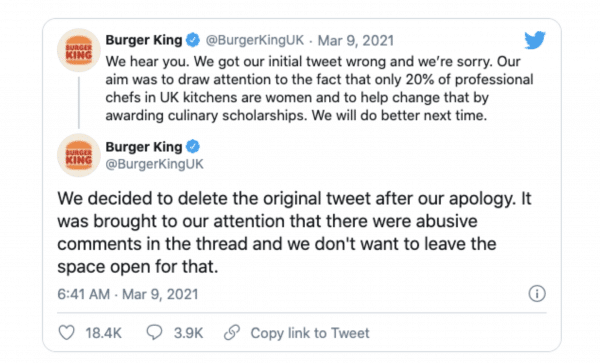
The aftermath of Burger King UK’s distasteful tweet on International Women’s Day this year.
When to Use Social Media Marketing
Social media is versatile, in that a variety of content can be created for every stage of your customer’s journey.
At the awareness stage, original content and posts can be curated to reach audiences who might have no idea about a new product or service you might have. At the consideration stage, ads can be targeted at certain groups of people.
At the purchase stage, ads targeted at driving a customer to make a purchase can be displayed to them. Also, if customers are satisfied with your product or service, you can encourage them to write a review for you on social media. They may also choose to post about your content independently, thereby giving your company social proof.
Social Media Marketing in Action
At the awareness stage, you can use social media to promote your organic content, such as blog posts. This allows your customers to understand the value your product or service will provide them.
Take a look at how Canva promotes their blog posts on their Twitter account:
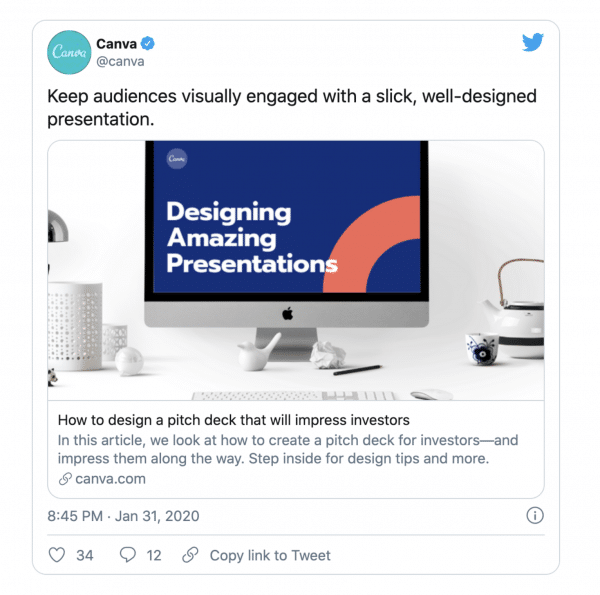
Canva utilises Twitter to promote their organic blog content.
At the consideration stage, once your customers continue through their journey, they’ll need more information about your product or service that would convince them that it stands out from your competitors’. This is when retargeting ads on a platform like Facebook would come in handy.
Take a look at how Zapier, a task automation service provider does this:
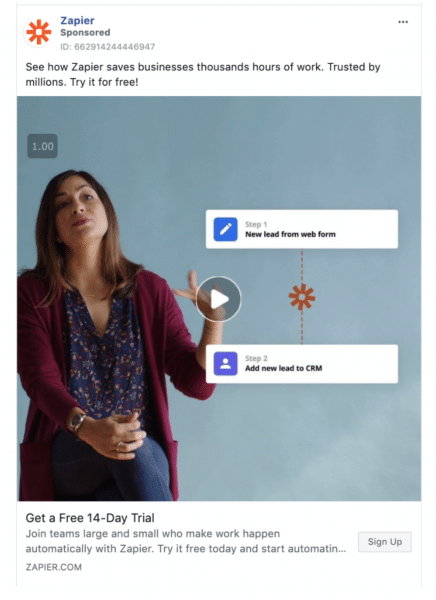
Zapier uses Facebook ads to retarget their customers at the consideration stage.
If your customers are still on their journey along your marketing funnel up until this point, it’s now time to use social media ads to give your customers an incentive to carry out a purchase. This could come in the form of a promotion to users who have previously interacted with your company on one of its platforms.
This is an example of how Casetify, a phone case and electronic accessory company uses Instagram ads to target their customers at the purchase stage:

An Instagram ad from Casetify targeting customers at the purchase stage.
Your interaction with your customers shouldn’t end at the purchase stage, as creating loyal customers and brand advocates who will give your brand social proof and word-of-mouth referrals is imperative to roping in new prospects.
There are a variety of ways brand advocacy campaigns can be carried out on social media. One possible way is to respond actively, perhaps with some humour and wit, wherever a customer tags your brand. This would encourage more people to generate organic content around your business.
Take a look at how Netflix US does this:
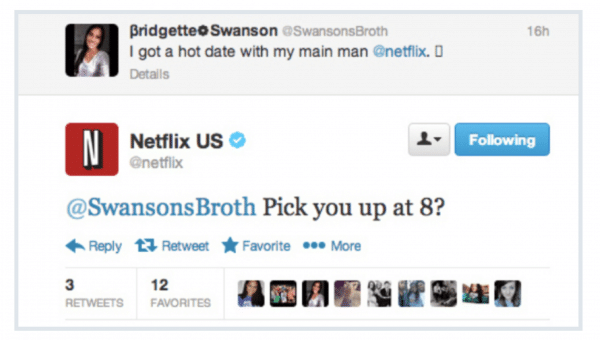
A witty one-liner like this would encourage more people to become advocates of your brand.
Channel 5 – Email
What is Email Marketing?
Email marketing is using email as a platform to target current or potential customers using a variety of content in an email to send a commercial message. The content in an email marketing campaign might include advertisements, business requests, newsletters, or sales promotions.
Email marketing is very powerful because it targets people who are on your mailing list – people who have agreed to let your business contact them, making them people with higher intent. Therefore the chance of converting with email marketing is higher than the other digital channels on this list.
How does Email Marketing Work?
One of the fundamental and most crucial steps to take when deciding to push out an email marketing campaign is to ensure your email list is up-to-date and is targeting the right group of people.
It is also important you are constantly building upon your existing list. An easy way to do this is to add opt-in forms on your website and social media channels.
Once your list is curated, it’s also imperative that you choose the right email marketing software to segment, send and manage your email campaigns and subscribers.
Some of the popular email tools include Mailchimp, Sendinblue and HubSpot, just to name a few.
Other steps in the email marketing campaign process include building responsive-design emails, with formats that cater to the various interfaces people will view the email on.
These days besides monitors, people use tablets and mobile phones. Crafting the copy, defining campaign goals and monitoring the effectiveness of the email campaign to optimise future ones are also some of the steps that need to be taken.
Check out our comprehensive guide on email marketing to learn how to create the best strategy for your brand.
The Pros and Cons of Email Marketing
Pros
1. High conversion rates
As mentioned above, email marketing generally has a higher conversion rate compared to the other digital marketing channels on this list due to the fact that your email subscribers generally already trust your brand and have a higher intent than prospects derived from other channels.
2. People Check their Emails Daily
Most people access their emails more than once a day, providing ripe opportunities for your business to garner the attention of the people that matter the most – those with high intent.
3. Email Marketing Drives Traffic to your Website
Good email marketing incorporates hyperlinks to your website or sales landing pages. This therefore will lead to an increase in site traffic and if your email content is crafted well, leading people to want to take action, this might even lead to customers converting on your site.
4. Easy to Track and Manage
With the right email marketing software, measuring the results of your email marketing campaign will be a breeze, allowing you to optimise your future campaigns based on the data collected.
Cons
1. Might be Treated as Spam
Sometimes, people forget they gave you their email address. This might lead to them marking your email as spam or unsubscribing from your emails. Also, if your email is too pushy and/or doesn’t add value to your subscribers, this might also lead to them unsubscribing.
2. Undelivered Messages
There are some internet service providers that filter out emails which use specific keywords that signify a higher likelihood of being spam. There is therefore a chance that your sales jargon may be misconstrued as spam and a portion of your subscribers won’t receive your email.
3. UX Differs
Your email might contain large-sized photos or graphics that might not download successfully. This might lead to your subscribers losing interest in your email and unsubscribing.
4. Crafting Efficient Campaigns Requires Skill
Good email marketing campaigns are crafted and optimised by people with the right skillets – from design to copywriting and knowledge of how to analyse data and optimise future campaigns or do A/B testing on campaigns.
When to use Email Marketing
Email marketing campaigns can be used to target customers at the consideration and purchase stages of their journey along your marketing funnel.
Email Marketing in Action
To generate new subscribers to your email list, consider offering potential customers the option to sign up on your website or through your social media platforms.
Here’s an example of what this might look like:

Offer users the option to sign up to be a part of your email list on your website.
At the consideration stage, send your subscribers an email that outlines the unique offers you have in store for them. Here’s how Trouva, a marketplace for independent boutiques in the UK, showcases their finds:
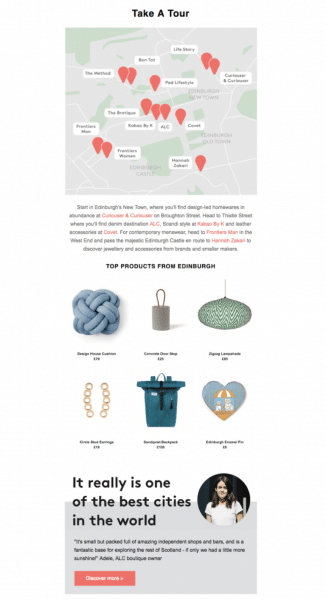
At the consideration stage of your customer’s journey, show-off your unique products and services to stave off competition.
At the purchase stage, send customers an email with an attractive offer that would persuade them to make a purchase on the spot. For instance, use a limited-time free shipping offer:

Persuade your customers to make a purchase by sending them an email with attractive, limited-time offers.
Mastery is Crucial
If you’re a digital marketer navigating the contemporary landscape, it’s well-known in the industry that the word ‘digital’ preceding marketer is becoming increasingly redundant. Being a marketer today requires one to be apt and confident with leveraging organic search, paid search, display advertising, social media and email to drive customers down their marketing funnel.
Using these 5 digital marketing channels well and at the right stages along your customer’s journey will see them making a smooth transition from one stage to the next. How well they convert along the way is up to how efficiently and effectively the channels are used.
If you find that you’re not aware of industry best practices when it comes to using these 5 digital channels, or that you don’t feel as confident as you know you should be when it comes to crafting the best strategies with these 5 digital channels at your disposal, it might be time to upgrade your skills and expand your knowledge with a course.
At Equinet Academy, we run courses that will set you up for success with the 5 digital channels:
- For organic search, consider taking our WSQ Search Engine Optimisation (SEO) Certification Course, where you’ll learn how to rank your website on page #1 of Google organically.
- When it comes to paid search and display advertising, our NICF WSQ Google Ads Search (SEM) and Display (PPC) Certification Course will make you a Google Ads certified professional.
- For social media and email, our WSQ Social Media Marketing (SMM) Certification Course and Email Marketing Course would be ideal for you to take if you wish to learn the best tools and strategies that are available for you to adopt for future campaigns.
- Equinet Academy also offers many other digital marketing courses that are either taught in-person in Singapore or online for you to choose from.
Zhong Li is the founder of Mikangle, a digital transformation company that focuses on advisory, training, and investment. He is also the Co-founder and now Advisor of Finty, an online financial marketplace that was acquired by an Australian firm, 15 months after the company was launched.